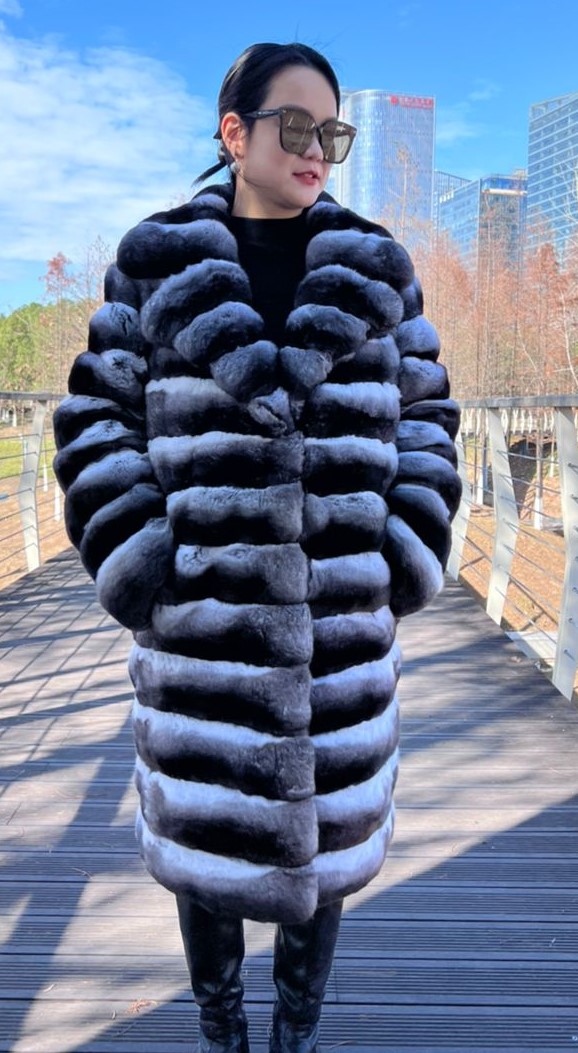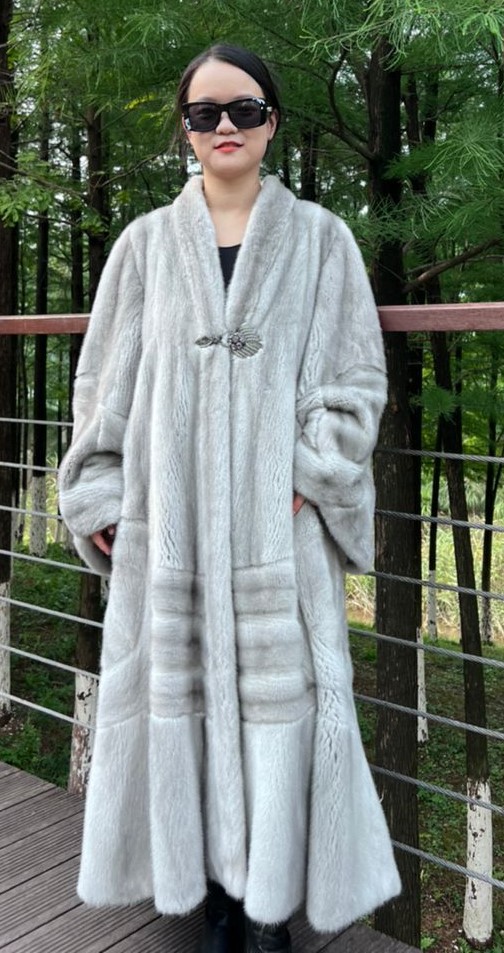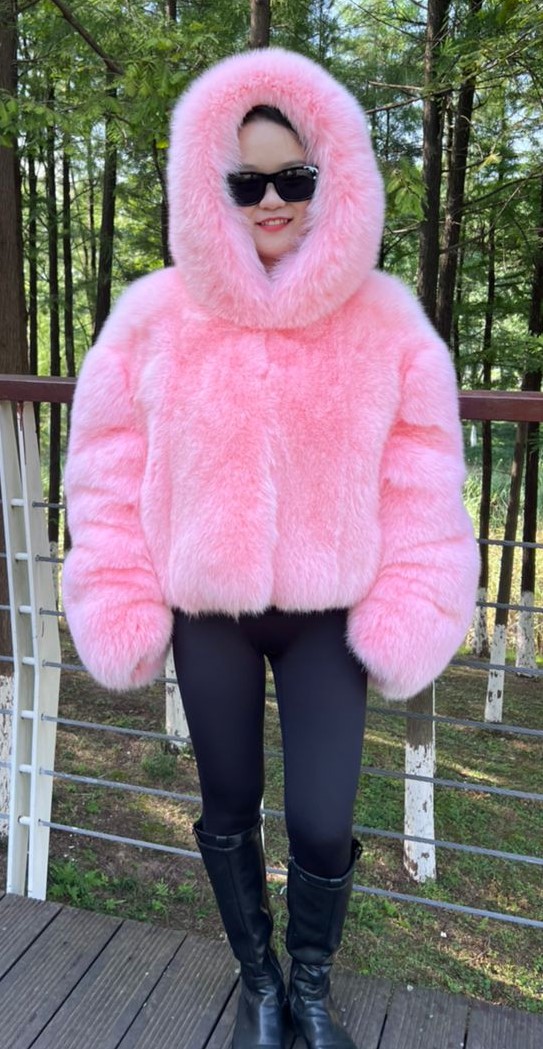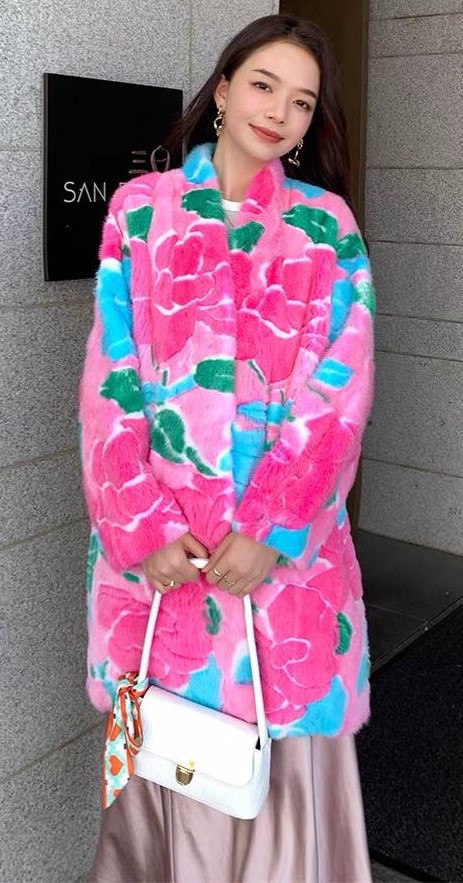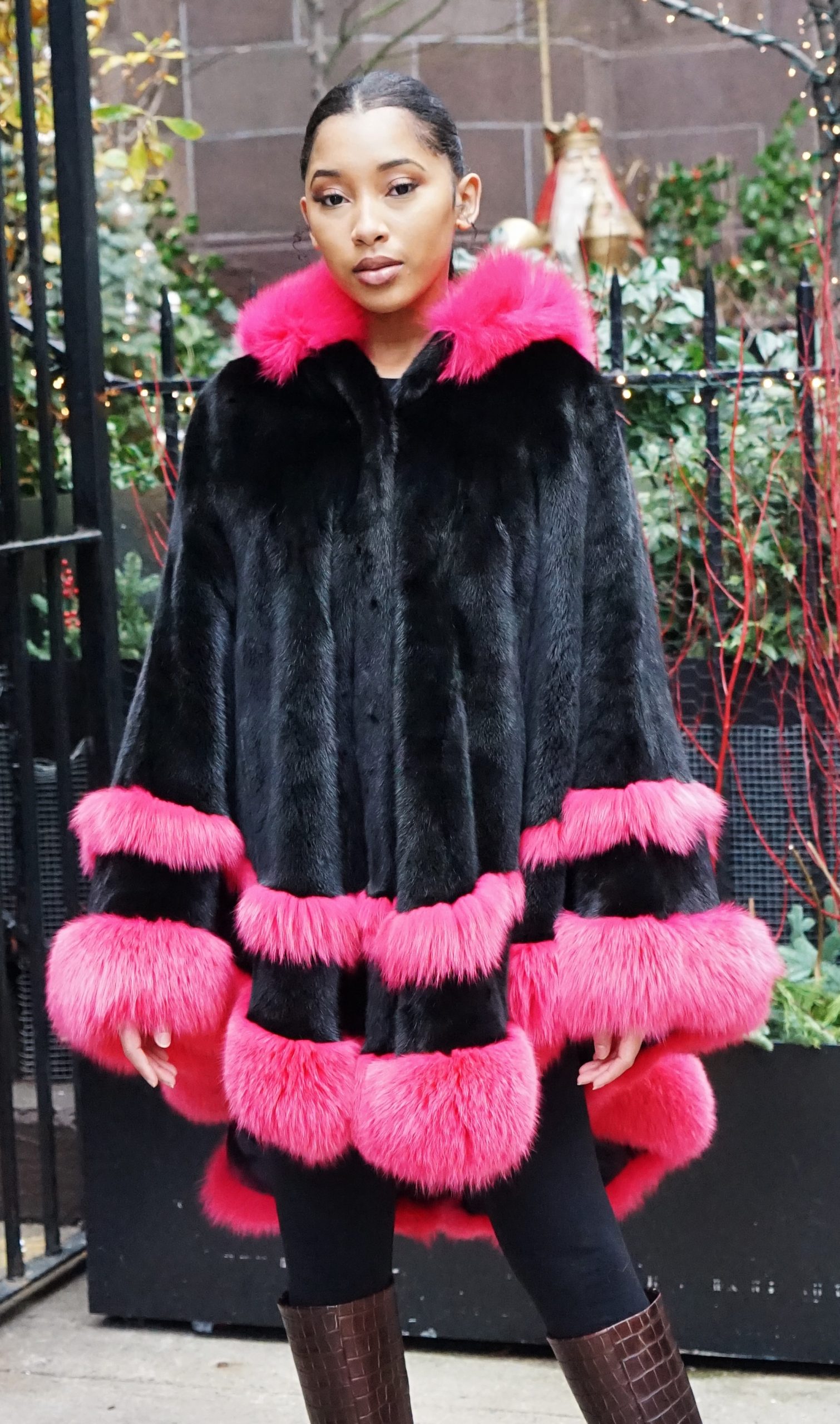Reasons to Wear Fur Coats in Chicago
Wearing a fur coat in Chicago, or any cold climate, can provide warmth and comfort during the harsh winter months. However, it’s essential to consider ethical and environmental factors when making fashion choices involving fur. Here are 100 reasons people might choose to wear a fur coat in Chicago, keeping in mind that some may prioritize warmth and style.
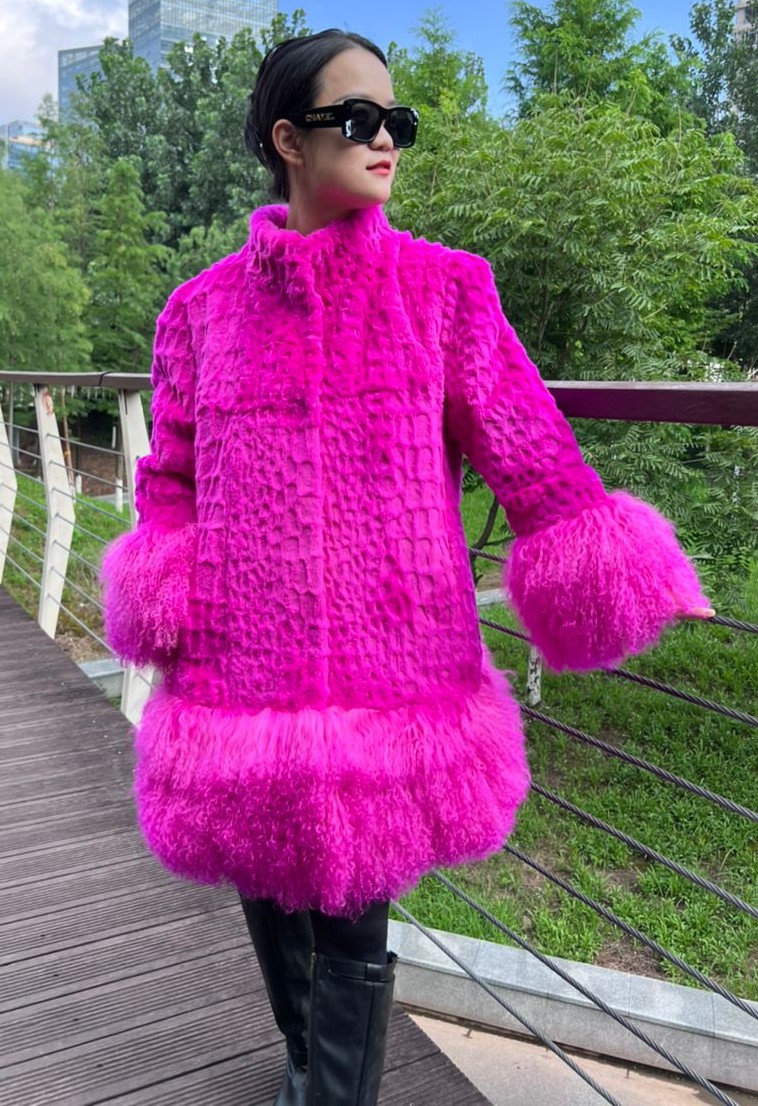
Pink Rex Rabbit Jacket Tibetan Lamb
- Exceptional warmth during Chicago’s cold winters.
- Protection against biting wind and frigid temperatures.
- Luxurious and classic style statement.
- Timeless fashion that doesn’t go out of style.
- Durability, as high-quality fur coats can last for many years.
- A sense of elegance and sophistication.
- Status symbol, denoting wealth and luxury.
- Comfort and coziness.
- Historical fashion tradition in cold climates.
- Practicality for surviving extreme cold.
- Enhanced insulation compared to synthetic materials.
- Natural insulating properties of fur.
- Soft and tactile texture.
Horizontal Chinchilla Coat
- Unique fashion choice that stands out.
- Vintage charm and appeal.
- Remembrance of past generations.
- Resistance to frost and moisture.
- Ability to layer underneath for added warmth.
- Iconic fashion choice for Chicago’s elite.
- Classic Hollywood glamour associated with fur.
- Support for traditional craftsmanship.
- Natural, biodegradable material.
- Customizable fur options to suit personal style.
- Variety of fur types and colors to choose from.
- Red carpet-worthy fashion for special occasions.
- Investment in a long-lasting wardrobe piece.
- Ability to dress up or down with different outfits.
- A symbol of opulence and extravagance.
- Timeless investment that retains value.
- Versatility in styling options.
- Sensual and soft to the touch.
- Ethereal elegance that fur can add to an outfit.
- Symbol of social status and success.
- Resistance to wear and tear.
- The craftsmanship involved in fur production.
Sapphire Directional Mink Coat
- Ability to create unique and eye-catching looks.
- Confidence boost when wearing luxurious fur.
- Effortless way to make a fashion statement.
- Allure and attention-grabbing quality.
- Contribution to the local fur industry.
- Warmth without the bulk of heavy winter clothing.
- Ability to withstand Chicago’s extreme weather.
- Support for traditional furriers and artisans.
- Soft and silky texture.
- Complementing various winter accessories.
- Comfort in sub-zero temperatures.
- Ability to retain body heat efficiently.
- Protection against freezing rain and snow.
- Unique and one-of-a-kind fur patterns.
- Symbol of elegance during Chicago’s social events.
- Contribution to the local economy.
- Soft colors that are pleasing to the eye.
Pink Fox Hooded Jacket
- A sense of indulgence and pampering.
- Environmental adaptability in varying conditions.
- Soft caress of fur against the skin.
- Ability to make a memorable fashion statement.
- Reduces the need for layering multiple garments.
- Opportunity to express personal style.
- Ethical and sustainable fur sourcing practices.
- Exceptional craftsmanship that goes into fur coats.
- Opportunity to support fur trade regulations.
- Tradition of fur fashion in cold climates.
- The luxurious feel of fur against the body.
- Ability to embrace Chicago’s winter fashion scene.
- Insulation that keeps you warm, even in blizzards.
- Traditional fur farming practices.
- Stylish and practical choice for formal events.
- Soft and supple fur textures.
- Dramatic flair that fur can add to an outfit.
- Proud representation of the fur industry.
- Opportunity to choose fur from ethically raised animals.
- Unique fur accessories like hats and scarves.
- Ability to invest in a family heirloom.
- Ability to appreciate the beauty of nature.
- Association with luxury brands and designers.
- Unique textures and patterns in fur.
Pink Floral Mink Coat
- Support for fur conservation and responsible sourcing.
- Elevated appearance in the workplace.
- Ability to stay warm without compromising style.
- Practicality for outdoor winter activities.
- Symbolism of prestige and exclusivity.
- Historic charm and cultural significance.
- Unique and exotic fur types.
- Soft and lustrous fur qualities.
- Ability to create a regal and majestic look.
- Sensual movement and gracefulness of fur.
- Contribution to sustainable fur farming practices.
- High-quality fur as an investment.
- Opportunities to mix and match fur accessories.
- The tactile pleasure of touching fur.
- Stylish addition to your winter wardrobe.
- Association with iconic fashion moments.
- Ability to choose from various fur treatments.
- Classic silhouette enhancement with fur.
- Pride in wearing a time-honored material.
- Opportunity to support ethical fur brands.
- A classic and enduring choice for Chicago winters.
- Natural beauty and texture of fur.
- Glamorous fashion option for the Windy City.
- Ability to celebrate the artistry of fur fashion.
Designer Lavender Mink Coat
Please note that while fur coats may provide warmth and have been a part of fashion traditions in cold climates, there are ethical and environmental considerations related to the use of fur. There are many reasons to wear a fur coat in Chicago.
A day for a woman in Chicago wearing her mink coat would vary depending on her personal preferences, activities, and the specific occasion. However, here’s a fictional representation of what a day might look like for someone wearing a mink coat during the colder months in Chicago:
Morning:
- Wake Up: The woman starts her day by waking up in the warmth of her cozy home in Chicago.
- Dressing: After a hot shower, she selects a stylish outfit to complement her mink coat. She opts for a knee-length black mink coat, a cashmere sweater, fitted jeans, and knee-high leather boots.
- Breakfast: She enjoys a hearty breakfast of oatmeal and a hot cup of coffee while catching up on the morning news.
- Preparing for the Day: She checks the weather forecast, which indicates a cold and windy day in Chicago.
Late Morning: 5. Leaving Home: She puts on her mink coat and wraps a matching scarf around her neck for added warmth. Before leaving, she grabs her leather gloves, designer handbag, and heads out the door.
- Errands: Her morning might include running errands, such as grocery shopping, visiting a local café for a latte, and stopping by the post office.
Afternoon: 7. Lunch: For lunch, she meets a friend at a chic downtown restaurant. She enjoys a delicious meal and conversation, all the while staying warm in her mink coat, which she drapes over her chair.
- Shopping: After lunch, she explores some of Chicago’s upscale boutiques, trying on clothes, and enjoying the luxurious shopping experience.
- Cultural Activities: In the afternoon, she might attend a cultural event, such as a museum exhibition, art gallery opening, or a performance at the Chicago Symphony Orchestra.
Evening: 10. Dinner Reservations: She has dinner reservations at a trendy restaurant in the city with her partner. Her mink coat adds an air of elegance to the evening.
- Evening Out: After dinner, they might choose to attend a theater show, concert, or a nightcap at a stylish cocktail bar.
- Returning Home: Upon returning home, she carefully hangs her mink coat in her closet and reflects on a day well spent in the vibrant city of Chicago.
Black Mink Poncho Fuchsia Fox Trim Hooded
This fictional day for a woman in Chicago wearing her mink coat highlights how such a garment can be both functional and fashionable, providing warmth and style throughout a busy day in a cold climate.
There are many reasons to wear a fur coat in Chicago.
The history of the fur business in Europe spans centuries and has been intertwined with fashion, economics, exploration, and the development of trade routes. Here is an overview of the history of the fur business in Europe:
Reasons to wear fur in Chicago
- Early Fur Trade: Fur trading was prevalent in Europe during ancient times. Indigenous peoples in northern regions, such as the Sami in Scandinavia and various tribes in Siberia, traded fur pelts with neighboring communities. These early fur trades primarily focused on warmth and protection from harsh climates.
Vintage Furs
- Roman Empire: The Roman Empire’s expansion brought access to new fur resources, such as the beaver, and fur became a symbol of status and luxury among the Roman elite. Fur garments were worn by emperors, generals, and aristocrats.
- Middle Ages: In medieval Europe, fur continued to be associated with wealth and social status. Nobility and clergy often wore fur-trimmed clothing and accessories. Fur pelts from animals like ermine, mink, and sable were highly prized.
- Renaissance: The Renaissance era saw a resurgence of interest in fur fashion. Fur-lined clothing, capes, and accessories were popular among European nobility and the emerging middle class. Fur became more accessible to a wider range of people.
- Age of Exploration: European exploration of the New World in the 15th and 16th centuries opened up new sources of fur, particularly in North America. Fur trading with indigenous peoples in North America became a lucrative business, with beaver pelts being highly sought after for hat production.
- Fur Trade Companies: European powers, such as the Dutch, French, and English, established fur trading companies, including the Dutch West India Company and the Hudson’s Bay Company, to exploit the fur resources of North America and Canada.
- Russian Fur Trade: Russia played a significant role in the fur trade, particularly in Siberia, where trappers, known as Siberian hunters, collected vast quantities of fur, including sable, fox, and marten. The fur trade was essential to the Russian economy.
- 17th and 18th Centuries: Fur fashion continued to flourish in Europe during the 17th and 18th centuries. Fur coats, cloaks, and accessories were worn by both men and women. Russian sable and other high-quality furs were highly coveted.
- North American Fur Trade: The North American fur trade continued to thrive, with European fur traders working closely with indigenous tribes to acquire furs. This trade played a role in the westward expansion of European settlers in North America.
- Furriers and Fashion: The fur industry supported the growth of furriers who specialized in designing and producing fur garments. Furrier guilds were established in many European cities, such as London, Paris, and Amsterdam.
- Industrialization and Mass Production: The 19th century saw the mechanization of fur processing, making fur garments more accessible to a broader range of consumers. The fur business began to expand globally.
- Decline and Resurgence: The mid-20th century saw a decline in fur fashion due to changing tastes, social concerns about animal welfare, and environmental awareness. However, fur fashion experienced a resurgence in the late 20th century, with designers incorporating fur into their collections
- Sustainable Fur Farming: In response to ethical and environmental concerns, the fur industry has evolved with an emphasis on sustainable and responsible fur sourcing. Fur farms in Europe and elsewhere have adopted practices aimed at improving animal welfare and conservation.
The history of the fur business in Europe reflects its cultural significance, economic importance, and evolution over time. While fur fashion remains a part of European heritage, it has adapted to address ethical and environmental considerations, reflecting changing societal values and preferences.
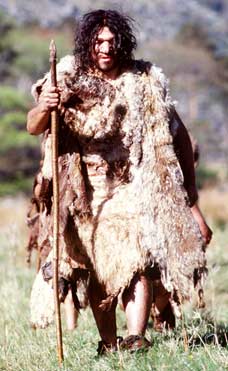
Mink Fur Mystique Equals Desire Marc Kaufman Furs
There are so many reasons to wear fur in Chicago
Marc Kaufman Furs NYC 212-563-3877
